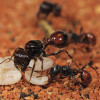Basking sharks, the second largest sharks in the world, have been tracked on epic, thousand-mile migrations into the deep waters of the West Atlantic, solving a long-standing mystery of where they spend the winter. Gregory Skomal from the Massachusetts Division of Marine Fisheries in the US led a team of scientists who tagged 25 basking sharks off the coast of New England.

As the satellites began beaming information back to the team they were amazed when the sharks kept on swimming south, into the Caribbean Sea and beyond. One shark even crossed the equator ending up at the mouth of the Amazon River on the Brazilian coast where it hung around for a month.
Their discovery has revolutionised our understanding of these mysterious basking sharks which until now were thought only to live in temperate waters. They have never been seen in this part of the world before, probably because they swim very deep down between 200 and 1000 metres.
The obvious explanation for their migrations is that these cold-blooded sharks need to find warmer water with lots of plankton, their favourite food. But what puzzles Skomal and his team is why the sharks bother going so far south. If food and warmer water were all they were after they could stay in northern Florida. Why bother going all the way to Brazil? One idea they came up with is that the sharks are moving to as yet undiscovered birthing and nursery grounds.
Amazingly, scientists have never seen a young or embryonic basking shark, so we know virtually nothing about how they breed. Previously it was thought that basking sharks form many separate sub-populations but now it seems they are well connected and could form a single ocean-wide population. That raises important issues of how we protect them, since any impacts on basking sharks in one area could have affects on the population as a whole. It could be nations around the world will need to get together and create a global basking shark conservation programme.
And this study just goes to show just how much more we still have to learn about some of the biggest creatures that roam the oceans today.
- Previous Plant trees. Save electricity.
- Next Musical Cockatoos










Comments
Add a comment